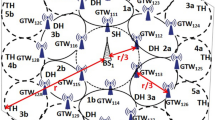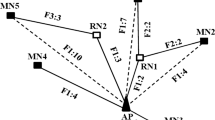Abstract
Traditional cellular networks provide a centralized wireless networking paradigm within the wireless domain with the help of fixed infrastructure nodes such as Base Stations (BSs). On the other hand, Ad hoc wireless networks provide a fully distributed wireless networking scheme with no dependency on fixed infrastructure nodes. Recent studies show that the use of multihop wireless relaying in the presence of infrastructure based nodes improves system capacity of wireless networks. In this paper, we consider three recent wireless network architectures that combine the multihop relaying with infrastructure support – namely Integrated Cellular and Ad hoc Relaying (iCAR) system, Hybrid Wireless Network (HWN) architecture, and Multihop Cellular Networks (MCNs), for a detailed qualitative and quantitative performance evaluation. MCNs use multihop relaying by the Mobile Stations (MSs) controlled by the BS. iCAR uses fixed Ad hoc Relay Stations (ARSs) placed at the boundaries to relay excess traffic from a hot cell to cooler neighbor cells. HWN dynamically switches its mode of operation between a centralized Cellular mode and a distributed Ad hoc mode based on the throughput achieved. An interesting observation derived from these studies is that, none of these architectures is superior to the rest, rather each one performs better in certain conditions. MCN is found to be performing better than the other two architectures in terms of throughput, under normal traffic conditions. At very high node densities, the variable power control employed in HWN architecture is found to be having a superior impact on the throughput. The mobility of relay stations significantly influences the call dropping probability and control overhead of the system and hence at high mobility iCAR which uses fixed ARSs is found to be performing better.
Similar content being viewed by others
References
R. Ananthapadmanabha, B.S. Manoj and C. Siva Ram Murthy, Multi-hop cellular networks: The architecture and routing protocol, in: Proc. IEEE PIMRC 2001 2 (October 2001) 78–82.
H. Balakrishnan, V.N. Padmanabhan, S. Seshan and R.H. Katz, Comparison of mechanisms for improving TCP performance over wireless links, IEEE/ACM Transactions on Networking 5(6) (June 1997) 756–769.
I. Chlamtac, M. Conti and J.J.-N. Liu, Mobile ad hoc networking: Imperatives and challenges, Ad Hoc Networks 1(1) (July 2003) 13–64.
M. Frodigh, P. Johansson and P. Larsson, Wireless ad hoc networking: The art of networking without a network, Ericsson Review 4 (2000).
M. Frodigh, S. Parkvall, C. Roobol, P. Johansson and P. Larsson, Future-generation wireless networks, IEEE Personal Communications 8(5) (October 2001) 10–17.
H.Y. Hsieh and R. Sivakumar, Performance comparison of cellular and multi-hop wireless networks: A quantitative study, in: Proc. ACM SIGMETRICS 2001 (June 2001).
H.Y. Hsieh and R. Sivakumar, Improving fairness and throughput in multi-hop wireless networks, in: Proc. ICN 2001 (July 2001) pp. 569–578.
Y.C. Hsu and D.B. Johnson, Caching strategies in on-demand routing protocols for wireless ad hoc networks, in: Proc. ACM/IEEE MOBICOM 2000 (August 2000) pp. 231–242.
IEEE Standards Board, Part 11: Wireless LAN medium access control (MAC) and physical layer (PHY) specifications, The Institute of Electrical and Electronics Engineers Inc. (1997).
D.B. Johnson and D.A. Maltz, Dynamic source routing in ad hoc wireless networks, Mobile Computing, edited by T. Imielinski and H. Korth (Kluwer, 1996) pp. 153–81.
Y.B. Ko and N.H. Vaidya, Location-aided routing (LAR) in mobile ad hoc networks, in: Proc. ACM/IEEE MOBICOM 1998 (October 1998) pp. 66–75.
K.J. Kumar, B.S. Manoj and C. Siva Ram Murthy, On the use of multiple hops in next generation cellular networks, in: Proc. IEEE ICON 2002 (August 2002) pp. 335–340.
S. Lee and M. Gerla, Dynamic load-aware routing in ad hoc networks, in: Proc. IEEE ICC 200110 (June 2001) pp. 3206–3210.
Y.D. Lin and Y.C. Hsu, Multi-hop cellular: A new architecture for wireless communications, in: Proc. IEEE INFOCOM 2000 (March 2000) pp. 1273–1282.
H. Luo, S. Lu and V. Bharghavan, A new model for packet scheduling in multi-hop wireless networks, IEEE/ACM Transactions on Networking 7(4) (April 1999) 473–489.
B.S. Manoj, D. Christo Frank and C. Siva Ram Murthy, Performance evaluation of throughput enhancement architectures for next generation wireless systems, ACM Mobile Computing and Communications Review 6(4) (October 2002) 77–90.
S. Murthy and J.J. Garcia-Luna-Aceves, An efficient routing protocol for wireless networks, ACM Mobile Networks and Applications Journal, Special Issue on Routing in Mobile Communication Networks 1(2) (October 1996) 183–197.
C.E. Perkins and E.M. Royer, Ad hoc on-demand distance vector routing, in: Proc. 2nd IEEE Workshop on Mobile Computing Systems and Applications (February 1999) pp. 90–100.
C. Qiao and H. Wu, iCAR: An integrated cellular and ad hoc relaying system, in: Proc. IEEE ICCCN 2000 (October 2000) pp. 154–161.
T.C. Tay and K.C. Chua, A capacity analysis for the IEEE 802.11 MAC protocol ACM/Baltzer Wireless Networks 7(2) (2001) 159–171.
H. Wu, C. Qiao, S. De and O. Tonguz, Integrated cellular and ad hoc relaying systems: iCAR, IEEE Journal on Selected Areas in Communications 19(10) (October 2001) 2105–2115.
X. Zeng, R. Bagrodia, and M. Gerla, GloMoSim: A library for parallel simulation of large-scale wireless networks, in: Proc. PADS 1998 (May 1998).
Author information
Authors and Affiliations
Corresponding author
Additional information
This work was supported by Infosys Technologies Ltd., Bangalore, India and the Department of Science and Technology, New Delhi, India.
B. S. Manoj received his Ph.D degree in Computer Science and Engineering from the Indian Institute of Technology, Madras, India, in July 2004. He has worked as a Senior Engineer with Banyan Networks Pvt. Ltd., Chennai, India from 1998 to 2000 where his primary responsibility included design and development of protocols for real-time traffic support in data networks. He had been an Infosys doctoral student in the Department of Computer Science and Engineering at the Indian Institute of Technology-Madras, India. He is a recipient of the Indian Science Congress Association Young Scientist Award for the Year 2003. Since the beginning of 2005, he has been a post doctoral researcher in the Department of Electrical and Computer Engineering, University of California, San Diego. His current research interests include ad hoc wireless networks, next generation wireless architectures, and wireless sensor networks.
K. Jayanth Kumar obtained his B.Tech degree in Computer Science and Engineering in 2002 from the Indian Institute of Technology, Madras, India. He is currently working towards the Ph.D degree in the department of Computer Science at the University of California, Berkeley.
Christo Frank D obtained his B.Tech degree in Computer Science and Engineering in 2002 from the Indian Institute of Technology, Madras, India. He is currently working towards the Ph.D. degree in the department of Computer Science at the University of Illinois at Urbana-Champaign. His current research interests include wireless networks, distributed systems, and operating systems.
C. Siva Ram Murthy received the B.Tech. degree in Electronics and Communications Engineering from Regional Engineering College (now National Institute of Technology), Warangal, India, in 1982, the M.Tech. degree in Computer Engineering from the Indian Institute of Technology (IIT), Kharagpur, India, in 1984, and the Ph.D. degree in Computer Science from the Indian Institute of Science, Bangalore, India, in 1988.
He joined the Department of Computer Science and Engineering, IIT, Madras, as a Lecturer in September 1988, and became an Assistant Professor in August 1989 and an Associate Professor in May 1995. He has been a Professor with the same department since September 2000. He has held visiting positions at the German National Research Centre for Information Technology (GMD), Bonn, Germany, the University of Stuttgart, Germany, the University of Freiburg, Germany, the Swiss Federal Institute of Technology (EPFL), Switzerland, and the University of Washington, Seattle, USA.
He has to his credit over 120 research papers in international journals and over 100 international conference publications. He is the co-author of the textbooks Parallel Computers: Architecture and Programming, (Prentice-Hall of India, New Delhi, India), New Parallel Algorithms for Direct Solution of Linear Equations, (John Wiley & Sons, Inc., New York, USA), Resource Management in Real-time Systems and Networks, (MIT Press, Cambridge, Massachusetts, USA), WDM Optical Networks: Concepts, Design, and Algorithms, (Prentice Hall, Upper Saddle River, New Jersey, USA), and Ad Hoc Wireless Networks: Architectures and Protocols, (Prentice Hall, Upper Saddle River, New Jersey, USA). His research interests include parallel and distributed computing, real-time systems, lightwave networks, and wireless networks.
Dr.Murthy is a recipient of the Sheshgiri Kaikini Medal for the Best Ph.D. Thesis from the Indian Institute of Science, the Indian National Science Academy (INSA) Medal for Young Scientists, and Dr. Vikram Sarabhai Research Award for his scientific contributions and achievements in the fields of Electronics, Informatics, Telematics & Automation. He is a co-recipient of Best Paper Awards from the 1st Inter Research Institute Student Seminar (IRISS) in Computer Science, the 5th IEEE International Workshop on Parallel and Distributed Real-Time Systems (WPDRTS), and the 6th and 11th International Conference on High Performance Computing (HiPC). He is a Fellow of the Indian National Academy of Engineering.
Rights and permissions
About this article
Cite this article
Manoj, B.S., Kumar, K.J., D, C.F. et al. On the Use of Multiple Hops in Next Generation Wireless Systems. Wireless Netw 12, 199–221 (2006). https://doi.org/10.1007/s11276-005-5267-x
Published:
Issue Date:
DOI: https://doi.org/10.1007/s11276-005-5267-x




